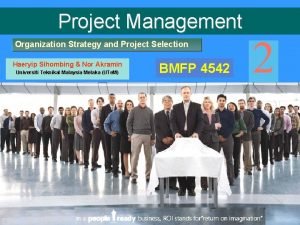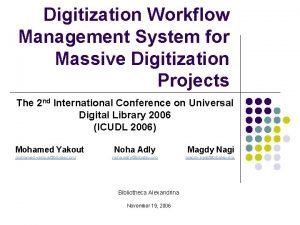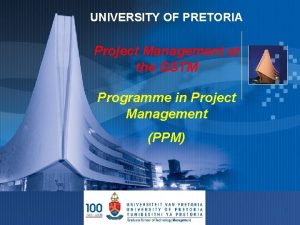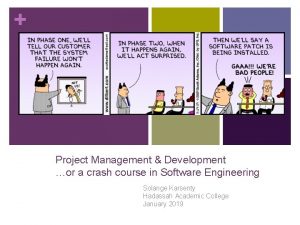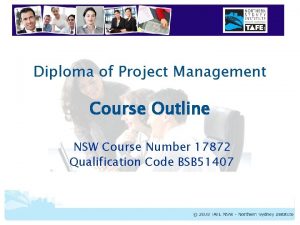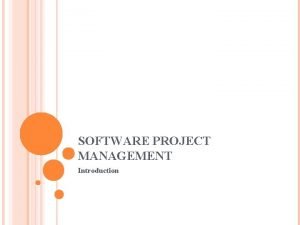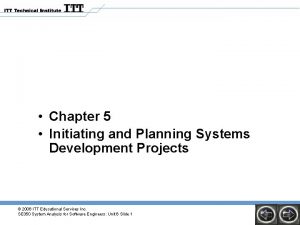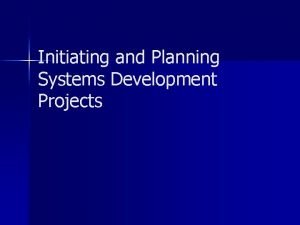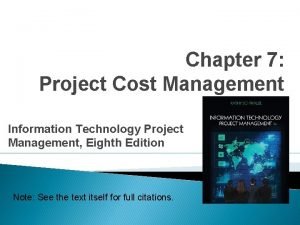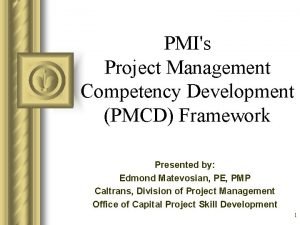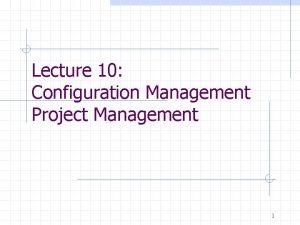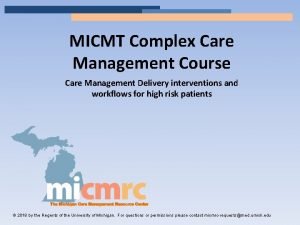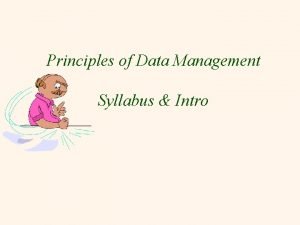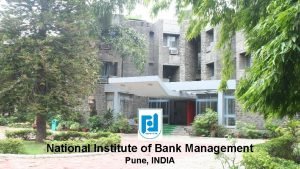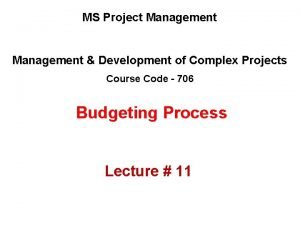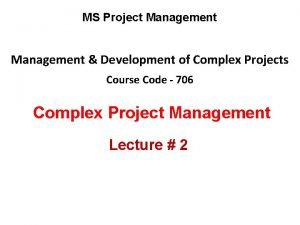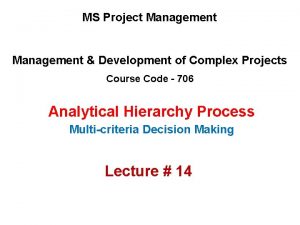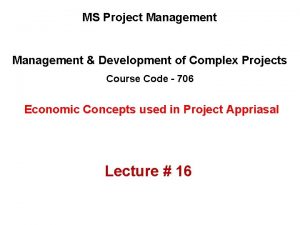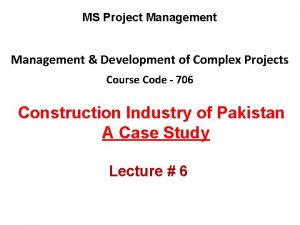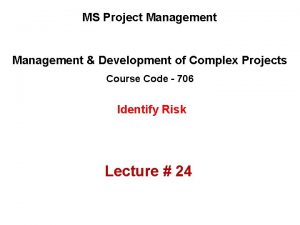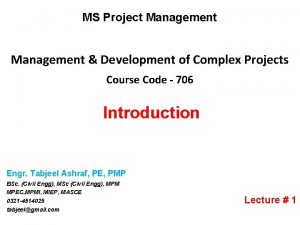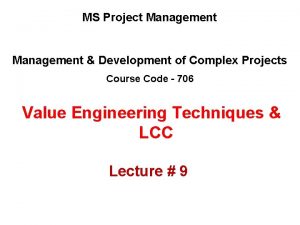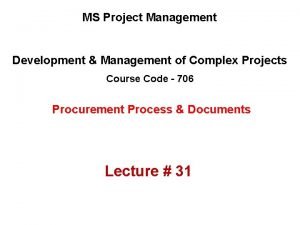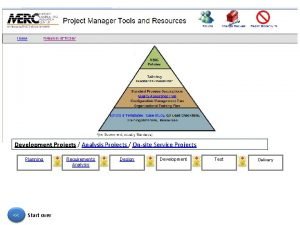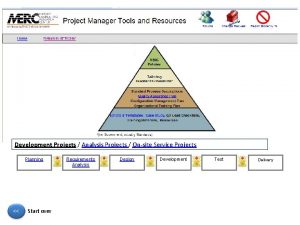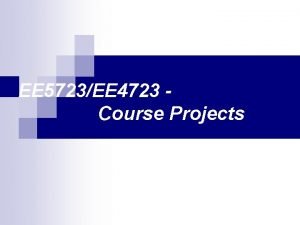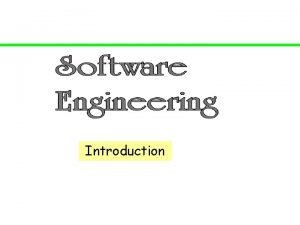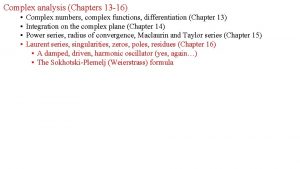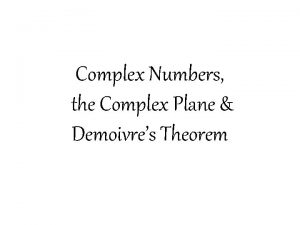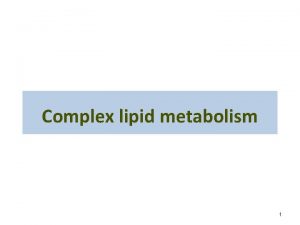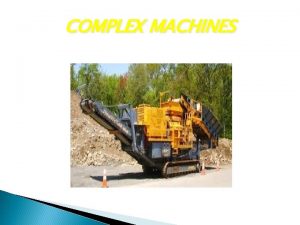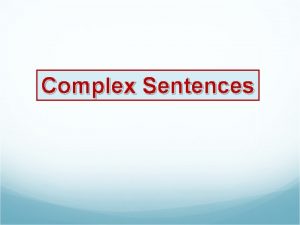MS Project Management Development of Complex Projects Course












































- Slides: 44

MS Project Management & Development of Complex Projects Course Code - 706 Plan Risk Management Lecture # 23

Summary of Previous Lecture In previous Lecture, we have discussed about Ø Ø Ø Ø Ø Definition of Risk management Importance & application of risk management Individual & overall project risk Stakeholder attitude towards risk management Risk management & communication Risk management framework Risk levels & thresholds Risk management processes

Plan Risk Management Defines the scope and objectives of the Project Risk Management process, and ensures that the risk process is fully integrated into wider project management.

Objectives of Plan Risk Management The objectives of the Plan Risk Management process are Ø to develop the overall risk management strategy for the project, Ø to decide how the risk management processes will be executed, and Ø to integrate Project Risk Management with all other project management activities.

Risk Management Plan Risk management plan describes how the risk management processes should be carried out and how they fit in with the other project management processes. RMP describes the relationships among Project Risk Management, general project management, and the management processes in the rest of the organization.

When to Start Risk Management Planning To provide the greatest benefit, initial risk management planning should be carried out early in the overall planning of the project. The risk management plan may subsequently need to be adapted as the needs of the project and its stakeholders become clearer or change

Cost of Risk Management The cost of treating the risks themselves should be included appropriately in the project budget, while the risk management plan should describe how this part of the project budget is evaluated, allocated, and managed.

Repetition of Activities risk management activities need to be repeated throughout the project. The risk management plan should define both the normal frequency for repeating the processes as well as specific or exceptional conditions under which the corresponding actions should be initiated. The corresponding risk management activities should be integrated into the project management plan.

Categories of Success Criteria There are two categories of success criteria for risk management: those for success of the project in general, and those for success of Project Risk Management. Namely as follow a) Project-Related Criteria. b) Process-Related Criteria.

Project-Related Criteria To assess the success of Project Risk Management, the stakeholders must agree on an acceptable level of results for the project-related criteria (such as cost, time, and scope). In order to ensure consistency and agreement among stakeholders, the risk management plan should present these objectives with reference to the project definition documents.

Process-Related Criteria The measures for success in Project Risk Management depend on a number of factors, such as the inherent level of uncertainty of the project. For example, the Project Risk Management process for a Dam construction project needs to address more unforeseen changes than for a project with a more predictable environment like construction of house.

Risk Register Risk management planning should establish the type and level of risk detail to be addressed and provide a template of the risk register that will be used for recording risk-related information.

Risk Related Communication Risk-related communication occurs at two levels: (a) within the project team, and (b) between the project team and the other project stakeholders. The principles for each of these categories of communication are defined in the risk management plan.

Risk Related Communication For the team, the plan describes the frequency and scope of risk management meetings and risk reports as well as the structure and content of such meetings and reports. For the other stakeholders, the plan sets their expectations as to the structure, content, and frequency of routine documents to be received. Details of the information required by the project team from stakeholders should also be clearly defined.

Plan Risk Management Process INPUTS Project scope statement Cost management plan Schedule management plan Communications management plan Enterprise environmental factors Organizational process assets Tools & Techniques Planning meetings and analysis OUTPUTS Risk management plan

Planning Sessions Planning sessions are recommended in order to build a common understanding of the project’s risk approach between project stakeholders and to gain agreement on the techniques to be used for managing risk.

Who Should Attend Planning Sessions The participants should include: the project manager, selected project team members and other stakeholders, members of the broader organization having responsibility for risk, and other subject matter experts or facilitators, as needed.

Output of Planning Sessions At this point, the initial risk responsibilities, methodology, templates, terms, definitions, time schedules, and cost budgets for the other Project Risk Management processes should be assigned and accepted.

Templates Risk management planning should take into account relevant existing templates for work products, such as risk status reports, risk breakdown structures or the risk register. A decision should be made as to which templates are relevant to the project, and these should then be adapted and included in the risk management plan.

Documenting the Results of the Plan Risk Management Process The results of risk management planning are documented in the risk management plan. The plan serves to provide all project stakeholders with a common view of how the riskrelated activities of the project will be handled, what has been agreed upon, and a description of the stakeholders’ involvement and responsibilities.

Project Scope Statement The project scope statement describes, in detail, the project’s deliverables and the work required to create those deliverables. The project scope statement also provides a common understanding of the project scope among project stakeholders.

Project Scope Statement The degree and level of detail to which the project scope statement defines the work that will be performed and the work that is excluded can determine how well the project management team can control the overall project scope

Project Scope Statement includes Product scope description. Progressively elaborates the characteristics of the product, service, or result described in the project charter and requirements documentation. Product acceptance criteria. Defines the process and criteria for accepting completed products, services, or results.

Project Scope Statement includes Project deliverables. Deliverables include both the outputs that comprise the product or service of the project, as well as ancillary results, such as project management reports and documentation. The deliverables may be described at a summary level or in great detail. Project exclusions. Generally identifies what is excluded as from the project. Explicitly stating what is out of scope for the project helps to manage stakeholders’ expectations.

Project Scope Statement includes Project constraints. Lists and describes the specific project constraints associated with the project scope that limits the team’s options, for example, a predefined budget or any imposed dates or schedule milestones that are issued by the customer or performing organization. When a project is performed under contract, contractual provisions will generally be constraints. Information on constraints may be listed in the project scope statement or in a separate log.

Project Scope Statement includes Project Assumptions. Lists and describes the specific project assumptions associated with the project scope and the potential impact of those assumptions if they prove to be false. Project teams frequently identify, document, and validate assumptions as part of their planning process. Information on assumptions may be listed in the project scope statement or in a separate log.

What is included in Risk Management Plan Depending upon the size and complexity of the project, some or all of the following elements will be present in a risk management plan. Ø Ø Ø Introduction; Project description; Risk management methodology; Risk management organization; Roles, responsibilities, and authority; Stakeholder risk tolerance;

What is included in Risk Management Plan Ø Criteria for success; Ø Risk management tools and guidelines for use; Ø Thresholds and corresponding definitions; Ø Templates; Ø Communications plan; Ø Strategy; and Ø Risk breakdown structure.

Introduction • • • Purpose Background Scope Statement Policy Approach

Executive Summary Under this heading, you have to give a summary of your risk management plan. The methodology to identify, analysis and different roles and responsibilities etc are discussed Then you have to identify the processes you intend to follow for risk management

Project Description Under this heading, you have to explain and narrate your project, the context of the project and then have to identify the ultimate objectives of your project.

Risk Management Methodology In this part, the methodology to be used is explained. All the relevant terms are explained and defined. All the processes are defined and narrated. And all the steps are given with examples.

Risk Management Organization In this part, the organization is defined which is ultimately responsible for the project risk management. The risk owners are defined and risk communications and their frequency is given

Roles, Responsibilities & Authority In this part, risk roles are assigned and defined. Then responsibilities of the individuals are defined for risk management. Risk management authority is delegated to different individuals in this part

Stakeholders Risk Tolerances In this part, risk tolerance of different stakeholders are defined and recorded

Criteria for Success In this part of Risk Management Plan, criteria for success of Risk Management is defined at both the levels i. e. project level criteria and process level criteria

Risk Management Tools & Guidelines In this part of Risk Management Plan, tools to be used for risk management are defined and explained. Guidelines for the use of these tools are also narrated

Thresholds In this part of Risk Management Plan, risk thresholds are defined after due analysis.

Communication Plan In this part of Risk Management Plan, different communication lines are explored with the context of risk management. Then mode and methods of communication are defined. etc

Strategy / Risk Response Planning In this part of Risk Management Plan, it is defined as what to do if a risk has actually occurred. Then the strategy is invoked in this part of plan.

Risk Breakdown Structure In this part of Risk Management Plan, the project risks are grouped and placed in hierarchical form. This is just like WBS

Summary of This Lecture In this Lecture, we have discussed about Ø Ø Ø Objectives of plan risk management Risk management plan When to start risk management Cost of risk management Plan risk management process What is included in risk management plan

End Note Failing to plan is planning to fail

THANK YOU!
 Project portfolio management matrix
Project portfolio management matrix Digitization workflow
Digitization workflow Introduction to software project management
Introduction to software project management Project management university of pretoria
Project management university of pretoria Project management crash course
Project management crash course Bsb51407
Bsb51407 Software project objectives
Software project objectives Initiating and planning systems development projects
Initiating and planning systems development projects Identifying and selecting systems development projects
Identifying and selecting systems development projects Initiating and planning systems development projects
Initiating and planning systems development projects Simple compound complex and compound-complex sentences quiz
Simple compound complex and compound-complex sentences quiz Miliary tb
Miliary tb Simple, compound-complex rules
Simple, compound-complex rules Freud complexes
Freud complexes Freudian ideas
Freudian ideas Latent fixation
Latent fixation Disadvantages of cavity wall
Disadvantages of cavity wall Course number and title
Course number and title Chaine parallèle muscle
Chaine parallèle muscle Risk management in telecommunication projects
Risk management in telecommunication projects Cost management in agile projects
Cost management in agile projects Project management lecture notes
Project management lecture notes Pmcd framework
Pmcd framework The role of project management in achieving project success
The role of project management in achieving project success Modern process transitions in spm
Modern process transitions in spm When reducing project duration
When reducing project duration Modern project management began with what project
Modern project management began with what project What is strategic assessment in software project management
What is strategic assessment in software project management Types of project audit in project management
Types of project audit in project management Microsoft project agile project management
Microsoft project agile project management Types of project termination
Types of project termination Situational frontline leadership
Situational frontline leadership Asset management vs project management
Asset management vs project management Configuration management project management
Configuration management project management Basic principles of cost management
Basic principles of cost management Ieee 828
Ieee 828 Project integration management
Project integration management Micmt
Micmt Top management and middle management
Top management and middle management Top management middle management first line management
Top management middle management first line management Top level management
Top level management Certified exhibition manager
Certified exhibition manager Data management course syllabus
Data management course syllabus Certification course in risk management nibm
Certification course in risk management nibm Certificate course in evidence based diabetes management
Certificate course in evidence based diabetes management
